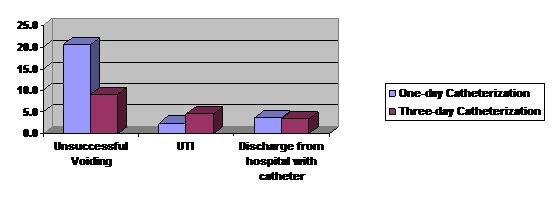Short-Term Versus Long-Term Catheterization After Vaginal Prolapse Surgery: Which Is Better?
To prevent over-distention of the bladder, clinicians rely on indwelling catheters for several days. However, little is know about the ideal length of time for catheter use. Although short-term catheterization can reduce hospital stays and urinary tract infections, it can also lead to increased postoperative voiding problems such as obstructive voiding and large residual volumes; these in turn can result in urinary tract infections and bladder dysfunction.
To prevent overdistention of the bladder, clinicians rely on indwelling catheters for several days. However, little is know about the ideal length of time for catheter use. Although short-term catheterization can reduce hospital stays and urinary tract infections, it can also lead to increased postoperative voiding problems such as obstructive voiding and large residual volumes; these in turn can result in urinary tract infections and bladder dysfunction.
To shed some light on this problem, researchers at the department of gynecology at the University Medical Center Groningen in Zwolle, the Netherlands, conducted a randomized prospective trial comparing outcomes for patients undergoing vaginal prolapse surgery with anterior colporrhaphy using 3-day suprapubic catheterization protocol (n = 88) versus 1-day suprapubic catheterization (n = 82). Mean age for patients was 60 years. All patients preoperatively received 1000 mg cefazolin and 500 mg metronidazole as antibiotic prophylaxis; the length of surgery was equal in both groups.
Following surgery, catheters were clamped (on the first or third morning after surgery, depending on the group), and patients were encouraged to void as soon as possible. Postvoiding residual volumes were measured by removing the clamp from the catheter. In cases where the patient could not void within the first 4 hours, the residual volume was measured, and the catheter was clamped for another 4 hours. When voiding attempts were unsuccessful during the day, the catheter was opened overnight and then re-clamped in the morning. Two consecutive residual volumes measuring less than 100 ml within 48 hours after clamping the catheter was considered as a successful voiding trial.
Urinary samples were collected from the catheters for sedimentation and cultures. The researchers diagnosed urinary tract infection if a patient had a positive culture (105 of one type of bacteria) as well as fever, dysuria, or leucocytes in the sedimentation.
In the group that had the catheter clamped after 1 day, the mean duration of days with catheter was 2.13 while the mean duration in the 3-day group was 3.55. Mean number of hospital days was also lower in the 1-day catheter group (2.94) versus the 3-day group (3.46). The researchers found that clamping the catheter 1 day after surgery as opposed to 3 days later resulted in a lower number of successful voiding trials (79.3% vs 90.9%); however, they did not find this difference to be statistically significant (Figure). Interestingly, the majority of patients who failed the voiding trial on the first day had concomitant surgery (eg, vaginal hysterectomy or sacrospinous fixation with anterior repair); the researchers think the related immobilization might have affected these patients’ ability to successfully void.
Figure. Comparison of outcomes (%).

The authors concluded, “Our data demonstrate that clamping of the suprapubic catheter and starting voiding trials on the first postoperative day results in a shorter duration of catheterization and hospital stay, without a difference in urinary tract infections and long-term catheterization.”
More Information
Preventing Catheter-Associated Urinary Tract Infections: Prevention of CAUTIReducing Use of Indwelling Urinary Catheters and Associated Urinary Tract Infections
Related Content
Forum: Fibroids Cause Women’s Lower Urinary Tract ProblemsConference Coverage:International Urogynecological Association
Poll
Reference
Van Der Steen A, Detollenaere R, Den Boon J, Van Eijndhoven H. One-day versus 3-day suprapubic catheterization after vaginal prolapse surgery: a prospective randomized trial. Int Urogynecol J Pelvic Floor Dysfunct. 2011 Mar 3.
